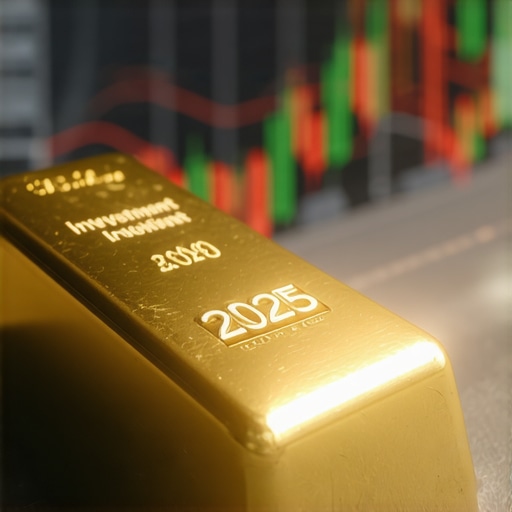Strategic Imperatives in Selecting Premier Gold Stocks and ETFs for 2025
In the evolving landscape of precious metals investing, pinpointing the best gold stocks and ETFs requires a sophisticated, data-driven approach that transcends conventional wisdom. As macroeconomic uncertainties and geopolitical tensions intensify, gold remains a pivotal asset class for portfolio diversification and inflation protection. However, not all gold-related securities deliver equal value, making an expert evaluation of underlying fundamentals and market dynamics imperative for identifying 2025’s true winners.
Decoding Gold Stocks: Assessing Operational Excellence and Market Positioning
Gold stocks offer direct exposure to mining companies whose profitability hinges on extraction costs, geopolitical risk, and production scalability. Leading candidates typically exhibit low all-in sustaining costs (AISC), robust balance sheets, and strategic mine locations with geopolitical stability. Incorporating environmental, social, and governance (ESG) metrics is increasingly critical, as regulatory pressures and investor preferences shift toward sustainable operations. Companies like Newmont and Barrick Gold exemplify these attributes, leveraging advanced extraction technologies and diversified asset portfolios to buffer against price volatility.
How Do Gold ETFs Differentiate Themselves in Risk-Adjusted Returns?
Unlike stocks, gold ETFs provide diversified exposure to physical gold or a basket of mining stocks, enabling investors to mitigate company-specific risks. ETFs such as SPDR Gold Shares (GLD) and VanEck Vectors Gold Miners ETF (GDX) differ markedly in their structure, with GLD tracking physical bullion prices, while GDX aggregates mining equities. Evaluating expense ratios, liquidity, and tracking accuracy is paramount. For 2025, ETFs that balance cost efficiency with strategic asset allocation will likely outperform in risk-adjusted terms, particularly amid fluctuating gold price forecasts.
Advanced Analytical Frameworks for Portfolio Integration
Optimal integration of gold stocks and ETFs demands an understanding of correlation matrices within broader asset classes and sensitivity to macroeconomic drivers such as real interest rates, U.S. dollar strength, and central bank gold purchasing policies. Leveraging insights from central bank gold purchases impact on market dynamics offers nuanced perspectives on supply-demand imbalances shaping prices. Additionally, strategic weighting informed by scenario analysis and volatility forecasting can enhance portfolio resilience and yield.
Investors seeking to deepen their understanding of gold investment strategies during economic uncertainty are encouraged to explore our comprehensive resource on best gold investment strategies for economic uncertainty in 2025.
According to a 2023 report by the Journal of Commodity Markets, integrating ESG factors and geopolitical risk assessment significantly improves predictive models for gold equity performance, underscoring the necessity of multidimensional analysis in selecting top-tier gold investments.
Harnessing Macroeconomic Indicators for Dynamic Gold Investment Decisions
Gold’s price trajectory is intrinsically tied to macroeconomic variables, including inflation rates, real interest rates, and currency fluctuations. For instance, an inverse relationship between real yields and gold prices often manifests as investors seek safety amid diminishing bond returns. Additionally, the U.S. dollar’s strength critically influences gold’s appeal in international markets. A softer dollar typically propels gold prices upward, whereas a robust dollar can temper demand. Investors must monitor these indicators dynamically to recalibrate their gold allocation effectively.
Moreover, the increasing role of central banks as gold buyers reshapes global supply-demand equilibria. Understanding the nuances of central bank gold buying’s influence on global demand offers invaluable insights into price pressure points and market sentiment.
Can Advanced Quantitative Models Predict Gold Market Volatility with Greater Precision?
Quantitative finance has introduced sophisticated modeling techniques, such as machine learning algorithms and GARCH models, to anticipate gold price volatility. These models assimilate diverse datasets—ranging from geopolitical event indicators to macroeconomic statistics—to generate probabilistic forecasts. However, integrating non-linear dependencies and black swan events remains a challenge, necessitating hybrid approaches that combine quantitative rigor with expert judgment.
Investors leveraging these models can tune portfolio risk exposure more finely, optimizing entry and exit points in volatile markets. For those interested in deepening their tactical approach, exploring mastering gold trading techniques for price volatility can provide actionable strategies.
Strategic Diversification: Combining Physical Gold, ETFs, and Mining Stocks
Robust gold portfolios often integrate multiple investment vehicles to balance liquidity, growth potential, and safety. Physical gold—whether in bars or coins—offers tangible asset security but entails storage and insurance considerations. Conversely, gold ETFs deliver liquidity and ease of transaction but are subject to tracking errors and market sentiment. Mining stocks provide leveraged exposure to gold prices but carry company-specific risks.
Allocating assets among these instruments demands a nuanced understanding of individual risk profiles and investment horizons. For example, younger investors might favor a higher weighting in mining stocks for growth, while risk-averse retirees could prioritize physical gold and low-cost ETFs. Detailed guidance on understanding types of gold investments can help tailor strategies.
Incorporating ESG and Sustainability Metrics into Gold Investment Analysis
The burgeoning emphasis on Environmental, Social, and Governance (ESG) criteria is reshaping gold investment paradigms. Mining companies with superior ESG ratings often demonstrate operational resilience, reduced regulatory risks, and stronger community relations—factors that contribute to long-term value creation. ESG integration requires evaluating data beyond financials, such as carbon footprints, labor practices, and governance structures.
Research indicates that ESG-compliant gold investments may outperform traditional peers in periods of market stress due to their sustainable operational models. Incorporating such metrics aligns portfolios with ethical considerations while potentially enhancing risk-adjusted returns.
For a comprehensive understanding of how ESG influences gold equities, consult the Journal of Commodity Markets, which provides empirical evidence supporting this trend.
We invite readers to share their experiences or questions about integrating advanced analytical frameworks and ESG considerations into their gold investment strategies in the comments below. Additionally, explore our detailed insights on best gold investment strategies for economic uncertainty in 2025 to further refine your approach.
Unveiling the Power of Machine Learning in Gold Market Forecasting
Recent advancements in artificial intelligence have ushered in a new era for gold market analysis. Machine learning (ML) models, particularly those leveraging deep learning architectures such as LSTM (Long Short-Term Memory) networks, have demonstrated remarkable capabilities in capturing complex temporal dependencies and non-linear patterns in gold price movements. Unlike traditional econometric models, ML approaches can ingest heterogeneous datasets—including satellite imagery of mining operations, social media sentiment analysis, and real-time macroeconomic indicators—to generate predictive insights with enhanced accuracy.
For instance, integrating sentiment data from geopolitical news streams alongside macro-financial variables enables these models to detect early signals of market stress or bullish momentum. However, challenges persist in terms of model interpretability and overfitting risks. Complementing ML forecasts with expert domain knowledge remains essential to mitigate these limitations and ensure robust decision-making frameworks.
What are the limitations and ethical considerations when deploying AI-driven strategies in gold investment?
While AI-driven models offer promising avenues for enhancing portfolio performance, they are not without pitfalls. The opacity of some algorithms can obscure underlying biases or erroneous assumptions, potentially leading to misguided investment decisions. Furthermore, data privacy and the ethical use of alternative data sources—such as satellite or social media data—must be carefully managed to comply with regulatory standards and maintain investor trust.
Portfolio managers must adopt transparent model governance, rigorous backtesting protocols, and continuous monitoring to address these concerns. Industry-wide collaboration to establish best practices is also emerging as a critical frontier.
Augmenting Traditional Metrics with ESG-Driven Alpha Generation Techniques
Progressive gold investors are increasingly deploying ESG analytics not only as a risk mitigation tool but as a source of alpha generation. Advanced ESG scoring models now incorporate real-time emissions tracking, water usage efficiency, and community engagement indices, which correlate with operational excellence and regulatory foresight. By integrating these dynamic ESG factors into multi-factor investment models, managers can identify mining companies poised for sustainable growth and superior financial performance.
For example, firms demonstrating proactive environmental remediation and transparent governance structures often experience fewer production interruptions and reputational risks, translating to more stable earnings. These insights are supported by the Journal of Commodity Markets, which empirically links ESG compliance with enhanced gold equity returns during volatile market phases.
Synergizing Gold Investment Vehicles: Tactical Allocation Frameworks for 2025
Effective portfolio construction involves dynamically balancing physical gold, ETFs, and mining equities to optimize exposure across different market cycles. Tactical allocation frameworks employ regime-switching models to adjust weights based on macroeconomic signals and volatility regimes. For instance, during periods of rising inflation expectations and geopolitical instability, increasing physical gold holdings may provide a safe-haven buffer, while in growth-oriented phases, mining stocks with high operational leverage could outperform.
Additionally, ETFs focused on ESG-compliant mining companies offer a hybrid solution combining liquidity with sustainability mandates. Integrating factor-based strategies—such as momentum and value overlays—within ETF selections further refines risk-adjusted returns. Investors can leverage scenario analysis tools to stress-test allocations against potential shocks like central bank policy shifts or currency realignments.
These sophisticated approaches require continuous data assimilation and expert calibration to navigate the evolving gold investment landscape effectively.
We encourage readers eager to deepen their expertise to explore our advanced resources on mastering gold trading techniques for price volatility and to engage with our community for peer insights and strategy refinement.

Integrating AI-Driven Insights with ESG Frameworks for Enhanced Gold Portfolio Performance
As the gold investment domain evolves, the convergence of artificial intelligence and ESG analytics is catalyzing unprecedented sophistication in portfolio management. By harnessing machine learning algorithms calibrated with real-time ESG indicators, investors can identify latent patterns that traditional models might overlook, such as emergent regulatory risks or shifts in community sentiment impacting mining operations. This fusion enables a proactive stance, allowing for tactical rebalancing that anticipates both financial and sustainability-driven market pressures.
Furthermore, dynamic ESG datasets—encompassing carbon emissions trajectories, labor rights compliance, and corporate governance transparency—when integrated into AI frameworks, facilitate more granular risk-adjusted return forecasts. This multidimensional perspective not only aligns with fiduciary responsibility but also positions portfolios to capitalize on the growing market preference for sustainable assets.
What methodologies best reconcile AI model interpretability with ESG data complexity in gold investment decisions?
One of the foremost challenges lies in balancing the black-box nature of complex AI models with the nuanced, qualitative aspects inherent in ESG data. Hybrid approaches, such as explainable AI (XAI) techniques, provide transparency by elucidating which ESG factors most influence predictive outcomes. Techniques like SHAP (SHapley Additive exPlanations) values and LIME (Local Interpretable Model-agnostic Explanations) empower analysts to validate model drivers, ensuring that investment decisions remain interpretable and justifiable to stakeholders.
Moreover, incorporating domain expertise through expert-in-the-loop paradigms refines model outputs by contextualizing ESG anomalies and mitigating data biases. This synergy enhances trustworthiness and regulatory compliance, critical for institutional adoption.
Exploring Blockchain’s Role in Enhancing Gold Supply Chain Transparency and Investor Confidence
Blockchain technology is increasingly recognized for its potential to revolutionize gold supply chain transparency, thereby augmenting investor confidence and ESG compliance verification. By providing immutable ledgers tracking gold provenance—from mine to market—blockchain mitigates risks of conflict minerals and unethical sourcing practices.
Initiatives such as the Responsible Gold Blockchain Consortium exemplify industry momentum toward adopting distributed ledger technologies to certify ethical mining operations and streamline audit processes. This innovation promises to bridge the gap between physical asset integrity and digital investment vehicles, enhancing traceability for ETFs and mining stock valuations alike.
Applying Scenario-Based Stress Testing to Gold Investment Portfolios Amid Geopolitical Uncertainties
In light of escalating geopolitical tensions affecting resource security and currency valuations, scenario-based stress testing emerges as an indispensable tool for gold portfolio resilience. Advanced simulation models incorporate multi-factor shocks—such as abrupt shifts in central bank gold reserves, sanctions on mining jurisdictions, or currency devaluations—to assess portfolio vulnerabilities and inform tactical asset reallocation.
Such rigorous stress testing facilitates preemptive risk mitigation strategies, including dynamic hedging and liquidity management, crucial for navigating the volatile landscape of 2025. Investors deploying these frameworks can better withstand systemic shocks while preserving upside potential.
For detailed methodologies and case studies on scenario analysis applied to gold investments, consult the CFA Institute’s expert guide on Scenario Analysis for Investment Decisions.
Elevating Tactical Allocation by Incorporating Alternative Data Streams in Gold Market Forecasting
Beyond conventional datasets, the incorporation of alternative data sources—such as satellite imagery measuring mining activity, social media sentiment analytics, and even energy consumption metrics—provides nuanced signals for gold market forecasting. When processed through advanced AI pipelines, these data augment traditional models, offering early warnings of supply disruptions or shifts in investor sentiment.
Notably, satellite-based assessments of mine production volumes can signal upstream supply constraints ahead of official reports, affording investors a tactical edge. Similarly, real-time sentiment derived from financial news and geopolitical developments can refine timing strategies for gold-related asset entry and exit points.
Augmenting Risk-Adjusted Returns Through Cross-Asset Correlation Optimization
Gold’s role as a diversifier is maximized by understanding its evolving correlation dynamics with other asset classes such as equities, fixed income, and cryptocurrencies. Recent research indicates that gold’s correlation patterns fluctuate significantly during market stress, necessitating adaptive correlation matrices within portfolio optimization algorithms.
Employing dynamic covariance estimation techniques, investors can recalibrate allocations to gold stocks, ETFs, and physical bullion in response to shifting co-movements, thereby enhancing overall portfolio Sharpe ratios and drawdown protection.
Engage with our advanced analytics toolkit and community discussions to refine your cross-asset allocation strategies and harness the full potential of gold investments in 2025.

How does the integration of ESG criteria with AI forecasting models influence regulatory compliance and investor trust?
Integrating ESG factors into AI-driven forecasting models not only advances predictive accuracy but also strengthens compliance with emerging regulatory frameworks such as the EU Sustainable Finance Disclosure Regulation (SFDR). Transparent ESG-AI integration fosters greater investor trust by demonstrating accountability and ethical stewardship, which are increasingly demanded by both regulators and asset owners.
This dual benefit encourages broader adoption of gold investment vehicles that meet stringent sustainability benchmarks while maintaining competitive financial performance, ultimately contributing to a more resilient and responsible market ecosystem.
Expert Insights & Advanced Considerations
Integrating AI and ESG Analytics Transforms Gold Portfolio Management
The convergence of machine learning techniques with real-time ESG data is revolutionizing gold investments by unveiling latent market patterns and regulatory risks often missed by traditional models. This integration enables proactive portfolio adjustments that align with both financial performance and sustainable investing mandates, enhancing risk-adjusted returns amid evolving market dynamics.
Dynamic Tactical Allocation Enhances Resilience Amid Market Volatility
Employing regime-switching frameworks and scenario-based stress testing allows investors to optimize allocations across physical gold, ETFs, and mining stocks in response to macroeconomic indicators and geopolitical shifts. This adaptive approach mitigates downside risks while capitalizing on growth opportunities, exemplifying sophisticated portfolio construction for 2025.
Alternative Data Streams Offer Competitive Edge in Forecasting
Utilizing satellite imagery, social media sentiment, and energy consumption metrics as supplementary inputs in predictive models provides early signals of supply disruptions and investor sentiment changes. Incorporating these alternative datasets enhances forecasting accuracy, enabling timely tactical decisions in the gold market.
ESG-Driven Alpha Generation Is Becoming a Strategic Necessity
Advanced ESG scoring systems that track emissions, water usage, and governance transparency correlate strongly with operational stability and superior equity performance. Integrating these dynamic ESG factors into investment models not only mitigates risks but also serves as a source of alpha, especially during periods of market stress.
Blockchain Technology Enhances Transparency and Investor Confidence
Implementing blockchain in gold supply chains ensures immutable provenance tracking, reducing risks related to conflict minerals and unethical sourcing. This technological advancement bolsters ESG compliance verification and strengthens investor trust in both physical and digital gold assets.
Curated Expert Resources
Journal of Commodity Markets: Provides empirical research linking ESG integration to improved gold equity performance and advanced modeling techniques for commodity markets, essential for deepening analytical rigor.
CFA Institute’s Guide on Scenario Analysis for Investment Decisions: Offers sophisticated methodologies for stress testing portfolios under geopolitical and economic uncertainties, crucial for building resilient gold investment strategies.
BuyingGoldNow’s Best Gold Investment Strategies for Economic Uncertainty 2025: A comprehensive resource that synthesizes tactical allocation, ESG considerations, and macroeconomic insights tailored for the current investment climate.
Responsible Gold Blockchain Consortium: Industry initiative focused on leveraging distributed ledger technologies to certify ethical gold mining and improve supply chain transparency.
Mastering Gold Trading Techniques for Navigating Price Volatility: Practical guide offering actionable strategies for optimizing entry and exit points using advanced quantitative models and market sentiment analysis.
Final Expert Perspective
As we navigate the complexities of gold investing in 2025, the integration of AI-driven insights with ESG frameworks emerges as a defining paradigm shift. This fusion empowers investors to anticipate regulatory, environmental, and market-driven changes with unprecedented precision. Coupled with dynamic tactical allocation and alternative data incorporation, these advanced strategies position gold portfolios to achieve superior risk-adjusted performance and sustainable growth. Embracing these multifaceted approaches not only aligns with fiduciary responsibilities but also unlocks novel alpha opportunities in an increasingly sophisticated market. Readers are encouraged to deepen their expertise by exploring our detailed analyses on best gold investment strategies for economic uncertainty in 2025 and to contribute their professional insights to foster a vibrant discourse on advancing gold investment methodologies.









